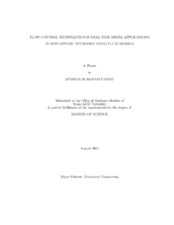| dc.description.abstract | Quality of Service (QoS) in real-time media applications is an area of current interest because of the increasing demand for audio/video, and generally multimedia applications, over best effort networks, such as the Internet. Media applications are transported using the User Datagram Protocol (UDP) and tend to use a disproportionate amount of network bandwidth as they do not perform congestion or flow control. Methods for application QoS control are desirable to enable users to perceive a consistent media quality. This can be accomplished by either modifying current protocols at the transport layer or by implementing new control algorithms at the application layer irrespective of the protocol used at the transport layer.
The objective of this research is to improve the QoS delivered to end-users in real-time applications transported over best-effort packet-switched networks. This is accomplished using UDP at the transport layer, along with adaptive predictive and reactive control at the application layer. An end-to-end fluid model is used, including the source buffer, the network and the destination buffer. Traditional control techniques, along with more advanced adaptive predictive control methods, are considered in order to provide the desirable QoS and make a best-effort network an attractive channel for interactive multimedia applications. The effectiveness of the control methods, is examined using a Simulink-based fluid-level simulator in combination with trace files extracted from the well-known network simulator ns-2. The results show that improvement in real-time applications transported over best-effort networks using unreliable transport protocols, such as UDP, is feasible. The improvement in QoS is reflected in the reduction of flow loss at the expense of flow dead-time increase or playback disruptions or both. | en |


